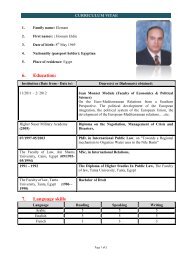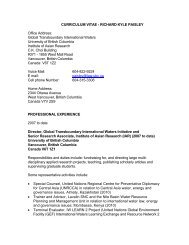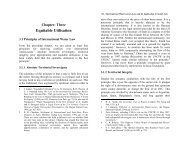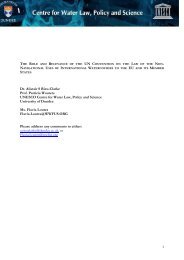Upreti, Trilochan, International Watercourses Law and Its Application ...
Upreti, Trilochan, International Watercourses Law and Its Application ...
Upreti, Trilochan, International Watercourses Law and Its Application ...
Create successful ePaper yourself
Turn your PDF publications into a flip-book with our unique Google optimized e-Paper software.
218 / <strong>International</strong> <strong>Watercourses</strong> <strong>Law</strong> <strong>and</strong> <strong>Its</strong> <strong>Application</strong> in South Asia Prospects <strong>and</strong> Problems of Nepalese Water Resources / 219within 30 years. 118 Nepal has already spent a huge amount ofmoney on these studies. 119 A series of talks <strong>and</strong> negotiationsbetween Nepal <strong>and</strong> India were held at a high level, <strong>and</strong> at atechnical level as well. It is worth noting that India hadreiterated its willingness to co-operate in the Karnali Project<strong>and</strong> also agreed to purchase surplus energy generated from it.Subsequently, on 4 February 1983, India <strong>and</strong> Nepal agreed toexecute three major multipurpose projects: Karnali,Pancheshwar <strong>and</strong> West Rapti; this was considered to be a majorbreakthrough in the field of bilateral co-operation in the waterresources sector, but nothing was achieved because Indiarefused to recognise some of the benefits recommended by theconsultant, particularly from flood control <strong>and</strong> irrigation. 120In addition to the above, the seventh meeting of the Karnali CoordinationCommittee (KCC), held in December 1988, showedserious differences over the sharing of the costs <strong>and</strong> benefits,<strong>and</strong> other components of the project; consequently, no tangibleagreements were possible. 121 Many governments over the pastfifteen years indicated great interest in the projects, <strong>and</strong> severaltalks were held; for example, the HHDC reports were thesubject of frequent discussion <strong>and</strong> a severe difference ofopinion emerged between the Nepali <strong>and</strong> Indian delegates.India has expressed a preference for a lower dam at Chisapanithat might yield around 7000 MW of electricity, <strong>and</strong> at areduced cost which would be easier to finance. She hasindicated two or three other upstream projects on the Karnalithat could be taken up, which, it is argued, would be morebeneficial, <strong>and</strong> needed in order to yield more energy. Moreover,a lower Karnali dam is also seen to pose less of a seismic118 Supra note 8 p. 328; also see supra note 20, p. 203.119 Supra note 21 pp. 203-204.120 Supra note 20, pp.203-204.121 Supra note 22, p. 344.problem <strong>and</strong> to cause less displacement of people. 122 TheIndian ideas remain unconvincing <strong>and</strong> seriously flawed from atechnical, legal <strong>and</strong> political point of view. The nonimplementationof the Karnali high dam, as observed by theeminent scholar <strong>and</strong> former Foreign Minster of Nepal, Shah,"furnishes a classical example of how the inherentweakness of a poor developing country renders ithelpless in the end against the interplay of variousforces represented by vested interest among thedonor countries <strong>and</strong> international agencies forfinancing. Nepal's much vaunted Karnali projectremains still unimplemented in spite of fourfavourable feasibility reports by internationallyreputed consulting agencies over a period of morethan two decades.” 123B. The Sapta Kosi High Dam ProjectIn Sanskrit, this river is called the Kausika <strong>and</strong> is one of thelargest tributaries of the Ganges. The Sapta Kosi river is thebiggest river basin in Nepal <strong>and</strong> is the third largest in Asia(after the Indus <strong>and</strong> Brahmputra); it has seven tributaries, 124some of them originating in Tibet <strong>and</strong> others in the Himalayanbelt by the Indo-China border. The catchment area is about25,600 sq km; the basin extends about 270 km from northwest122 The main objection from the Indian side was that the project area was20 miles within Nepalese territory <strong>and</strong> as such their control over solarge a base of power would be limited, <strong>and</strong> therefore security wasinadequate. Whereas in Nepal, some went so far as to ask 'will Nepalown the Karnali, or the Karnali own Nepal because of the magnitude ofthe project <strong>and</strong> about Nepal’s capacity to h<strong>and</strong>le it properly. Also seesupra note 4, pp.209-210.123 R. Shah, "Politics of Water Power in Nepal" (1994) in 4 Water Nepal,pp. 286-287.124 Supra note. 21, pp. 48-50. Name of these tributary rivers are, theTamur, the Arun, the Sunkosi, the Tamakosi, the Dudhkosi, theBhotekosi, <strong>and</strong> the Indrawati.












